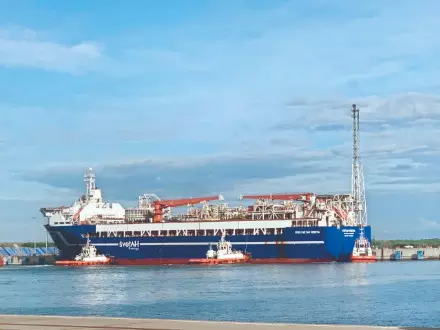ONGC led JV resumes production from PY-3 offshore petroleum field

New Delhi: The resumption of the PY-3 offshore petroleum field in India’s Cauvery Basin, following a 14-year gap, is a milestone success in offshore hydrocarbon development, underwritten by state-of-the-art technological innovation, strategic partnership, and renewed focus on energy sovereignty. This resurgence, led by a consortium of Oil and Natural Gas Corporation Ltd (ONGC), Hardy Exploration & Production (India) Inc. (HEPI), and Invenire Petrodyne Ltd (IPL), is the best example of how high-tech engineering solutions and public-private partnerships can revive underutilised assets while harmonising with national energy security needs.
Technological reengineering: A blueprint for offshore revival
The revival of the PY-3 field was contingent upon a carefully planned multi-phase Field Development Plan (FDP) aimed at fixing both the legacy issues as well as modern operational requirements.
Beginning with, key to Phase I, was the revival of the PD3SA subsea well, an accomplishment delivered through state-of-the-art well completion technologies and updated flow control systems. The installation of cutting-edge subsea infrastructure—such as high-efficiency manifolds, subsea trees, and remotely operated vehicle (ROV)-friendly equipment—allowed accurate hydrocarbon recovery while reducing operational risk. Not only did this infrastructure upgrade revive productivity but it also integrated fail-safe devices to buffer environmental and technical risks inherent in deepwater drilling.
Floating production, storage, and offloading (FPSO) technology
The FPSO Svetah Venetia integration represented a paradigm shift in offshore processing capacity. The floating facility, with cutting-edge separation and processing modules, enables real-time separation of oil, gas, and water at the field of extraction itself. By doing away with the requirement for fixed offshore structures, the FPSO provides greater operational flexibility, lower capital outlay, and simplified logistics. The Svetah Venetia is also used as a temporary storage facility for PY-3’s premium light sweet crude (low sulfur, high refinery yield), which is offloaded from time to time to shuttle tankers for shipment to coastal refineries. This modular design is part of worldwide offshore trends towards adaptive cost-efficient offshore solutions. Enhanced Oil Recovery (EOR) and Drilling Innovations Phase II of the FDP will apply state-of-the-art EOR methods to enhance reservoir efficiency.
Techniques such as gas lift injection —which maximizes well pressure to increase crude flow—and lateral well drilling will be able to access previously untapped reservoir sections.
Such technologies solve problems such as decreasing natural pressure and residual oil saturation, typical for mature fields. Also, directional drilling technologies will allow for accurate targeting of hydrocarbon reservoirs, reducing geological uncertainties and improving recovery rates. These innovations place PY-3 as a proving ground for India’s offshore field optimization ambitions. Digitalisation and automation although not necessarily enumerated in project releases, the turnaround probably made use of digital twin modelling, predictive analysis and automated monitoring systems—pillars of contemporary offshore operations. These technologies allow for real-time data capture, predictive maintenance, and remote monitoring of subsea infrastructure, minimizing downtime and operational expense. The wider industry environment, encompassing simplified regulatory approvals through digital permitting systems, highlights the position of digital transformation in driving project timing.
The ownership structure of the PY-3 block mirrors a balanced mix of experience and investment:
ONGC (50.63 per cent interest): With its status as India’s hydrocarbon centrepiece, ONGC contributes unmatched technical resources, supplying 63 per cent of the country’s oil and gas production and controlling seven of India’s eight producing basins.
HEPI (22.79 per cent ): Invenire Energy Group’s subsidiary, HEPI utilizes its heritage of expertise in offshore innovation, as it developed India’s first floating production system at PY-3 in 1997.
IPL (26.58 per cent ): Originally Tata Petrodyne, IPL is Invenire’s upstream division with cross-border operating history in Indonesia and India.
This tripartite partnership is a model of how public-sector diligence and private-sector nimbleness can come together to propel intricate projects. Support from India’s Ministry of Petroleum and Natural Gas and the Directorate General of Hydrocarbons (DGH) eased regulation, facilitating approvals while adhering to environmental and safety standards.
Legacy meets innovation: Pioneering India’s offshore future
The PY-3 revival is not merely a technical achievement but a symbolic bridge between India’s hydrocarbon legacy and its future energy aspirations. HEPI’s 1997 milestone—introducing floating production and subsea completion systems to India—has been reimagined through contemporary engineering, blending decades of operational insights with breakthroughs in subsea robotics, materials science, and reservoir modelling.
Manish Maheshwari, Invenire Energy Chairman, and Arunangshu Sarkar, ONGC Director, highlighted the project’s congruence with India’s National Energy Policy to minimize crude import reliance (at present in excess of 85 per cent) by reviving domestic upstream capabilities. The PY-3 field’s light sweet crude with low refining complexity serves this purpose directly by substituting more expensive, sulfur-laden imports.
Wider implications: A model for sustainable growth
The PY-3 revival has strategic value beyond near-term production benefits, the Cauvery Basin success could trigger investment in surrounding offshore blocks and monetize its common infrastructure and learning. The project sets a precedent for reviving shut-in fields, estimated to hold 30–40 per cent of India’s yet-to-unlock hydrocarbon reserves, using phased FDPs and EOR. By maximizing proven assets, India can reconcile its fossil fuel dependence with renewable energy aspirations, providing transitional energy security.
ONGC’s participation in seven non-operating joint ventures yet again reflects its position as a co-leader, facilitating knowledge-sharing and risk-partitioning in high-risk offshore ventures. The revamp of the PY-3 field is a perfect example of the synergy between technical innovation, strategic partnership and policy-inspired vision. By leveraging subsea technology, FPSO modularity, and EOR innovation, the consortium has breathed new life into a non-producing asset and made it a cornerstone of local energy production.
As Phase II gets underway, the project will not only enhance India’s crude production but also enhance its ability to master the intricacies of offshore hydrocarbon production in the age of energy transition.
This success speaks to a larger reality: in pursuit of energy independence, mastery of technology and collective determination are essential.



